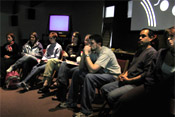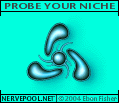
_______________
Terms for a Living Media Culture
_____________
These are terms I've cobbled together over the years to help formulate a cultural practice in response to the onward rush of new technology. A number of them have been used in the context of the media rituals I explored in Brooklyn in the early 1990s.
Hyper-Runt
A cultural process, art event or artificial lifeform which, through some unexpected mutation or character trait, jumps category and comes alive as a media virus or meme. A hyper-runt takes on an attitude of its own, distinctly different from that which its inadvertent creators intended. I came up with this term while working on a new media exhibition for Inliquid in 2004. (See Hyper-Runt exhibit)Bionic Code
A system of bionic ethics where a network diagram and an aphorism are distributed through electronic media to encourage a system of non-violent problem-solving routines. I came up with the term in 1992 when I abandoned the more awkward phrase, "social programs," to describe a series of computer-generated network symbols. (See Netlingo.)Zoacode
My Bionic Codes evolved into Zoacodes in the late 1990s; a metaphor of circuitry gave way to one of neurons and "living codes." Like their predecessors, Zoacodes propagate in the plasma of media and popular culture and are intended to induce graceful relationships. Zoacodes have been cultivated to operate as stand-alone media viruses as well as mental stimulants in my narrative motion picture, Glimmers in the Nervepool.Wigglism
Born in an age of multimedia interactivity, fuzzy logic and artificial lifeforms, Wigglism approaches truth as a living blur of interactivity. The term Wigglism itself is intended to be a lively goad for nurturing a vital dialogue. The very definition of Wigglism is emerging through dialogue, beginning with a Manifesto I launched on the internet in 1996.Wigglist
One who abandons art, science and religion for the immediate satisfaction and responsibility of nurturing every situation into a lively form. This wiggly entity or worldform (weltanform as opposed to weltanschauung) emerges into being through continuous interaction with the world. A wigglist abandons objectivity and connoisseurship for participation: she doesn't communicate at the world, but rather intercodes with the world, helping to nurture into being a collective, evolving, truth-as-liveliness.Media Spore
A code which unleashes a mature "Media Organism." See below.Media Organism
In 1992 I presented an exhibit at Test-Site gallery in Williamsburg, Brooklyn, called Heat-Seeking Psycho-Suctions. These squiggly focal entities, projected on the floor, were triggered by people walking through the gallery. The code for the computer-generated forms was dubbed a "media spore" while the more complex set of symbiotic relationships between the user, the projection and the code was deemed a "media organism." Media Organisms are "herded" and "cultivated" as opposed to "created."Media Breeder
One who breeds and cultivates "Media Organisms."Expressionist Programming
In 1984 while writing code for a computer game at MIT, a strange effect was unleashed which I hadn't planned for. When running the program a user would let loose jets of blue lines which streamed across the screen and began propagating beyond any controls available to the user. Rather than scrapping the program, I tweaked the code to enhance and focus the strange effect. Although I overhauled the code later to complete the game, the earlier anomaly has stuck in my mind. I decided to call my working method "Expressionist Programming." Allowing the computer some breathing room, as it were, and being alert to unintended effects, set up an expressive space in which the programmer, the computer and the user combine into an expressive ecosystem. The screwed up, but delightfully eerie, game was clearly something I would later call a Hyper-Runt. (see above).

Web Jam, Born 1993Web Jam
A weblike layering of humans, media and ecosystem into a singular, pulsing jam. (See Web Jam at Netlingo.)Media Compression
In New York in 1990 I launched a series of community-based events called Media Compressions. These media rituals were an attempt to collectivise media consumption in a circular "media war room."

Media Compression at Simpson College
Indianola, Iowa, 2004Weird Thing Zone
In New York in 1990 I set up a zone within a Williamsburg, Brooklyn community festival where artists, children, roboticists and others could set up phenomena which transcended their category for the general delight and mental exercise of all. By presenting the stuff simply as "weird things," it bypassed the usual prejudices which afflict most products of professional tinkering. This is a close cousin to Hakim Bey's Temporary Autonomous Zone (or T.A.Z.)Intercoding
To approach communication as an attempt to congeal into a social organism through mutual programming. Intercoding can take place between different species, objects and machines. We and our environment program each other.The Radical Center
I published the following manifesto in Zine Magazine and 188 Magazine, Brooklyn, 1990. I first distributed the manifesto on a poster in New York in1989.THE RADICAL CENTER: To insist on perfection is to stand inside a fortress: all who agree with us stand within, all who disagree become our enemies. An oppositional dialogue ensues leading to blindness and war. Such is the results of the fictions left and right, East and West, popular and elite, art and politics. To believe that opposites are an essence of nature is to reveal an ignorance of continuums. It is far better to admit that all political and cultural positions are momentary flashes in the flood of cultural evolution. In the place of dichotomies, let us substitute a process. Let us meet in the village center, the mental center, in that space of open inquiry which melts down all particularities. Let us embrace an attitude of restless integration. Let us entwine around shared languages, familiar reference points, and common paradigms. Let us sing our songs and offer our challenges in the nodes of such webs, there in that ubiquitous, ever-changing, radical center.
Hyper Psychology
All terms evolve in meaning and this one is bound to be highly volatile. As robotics and cybernetics become increasingly more complex, if not human, it is tempting to form a kind of "robot psychology" to cope with such an emerging presence in our lives. However, there are real doubts as to whether machines will ever adequately simulate our biological nuances. What we need instead is a Hyper Psychology to investigate how the human psyche navigates through a sea of machinery, information, media and prosthetic devices.Even if a true Hal or Astroboy were to emerge out of the computer labs, their very similarity to humans would necessitate a similar form of Hyper Psychology to help them, and us, cope with our ever-multiplying phylum of gadgets. It is now widely recognized that roboticists are barking up the wrong tree if they are still attempting to simulate human beings, an organism which evolved for millions of years out of atomic elements. Until the scientists employ the same bottom-up, evolutionary strategy of construction, they will always fail to arrive at our sublime, tangled complexity. The scientists may as well strip off their lab coats, have sex and make babies. I can vouch that it works.
Hyper Psychology isn't merely about a humanoid response to the machine-world. It's about a new form of humanity with a machine-enhanced nervous system responding to an evolving planetary ecosystem. A hyper psychologist recognizes that we were never singular beings in the first place and that our minds have always been constructed through an interplay, and an intercoding, with our environment. As we arrange things in our external world (in collaboration and competition with other arrangers) we arrange our minds, our dreams and our future actions. Like Freud's original and rather radical notion of an unlimited, probing psyche, a Hyper Psychology would, at best, defy any limits to its definition. Its purpose would be to liberate our sense of being, and possibly even re-connnect us meaningfully with the crawling, everlasting wilderness. In this post-human, interactive, wiggling age, Hyper Psychology and Hyper Therapy would amount to the same thing.
Here's a movie outline to elaborate on the question of where to place the soul of robot psychology and the need to widen it into a form of hyper psychology:
Shazock the robot is so sensitive she can hardly cope with the stresses of 21st century life. She constantly critiques the other machines in her midst and runs off on a romantic quest for communion with the infinite. "I insist that I am a wild and singular being," she bellows at the moon. "I shall dance unimpeded by the repugnant, constricting technologies which contaminate my civilization." Just as Shazock reaches a state of intense revelation, she discovers that she, too, is a machine. "Skrod!" she declares, staring straight at the camera, "Oh, whatever. The issue is not machines vs. organic life. It's about some explosive sense of creation which all matter is participating in. Crank up the new hybrid Bjork/Hendrix/Plankton mix." --Ebon Fisher
